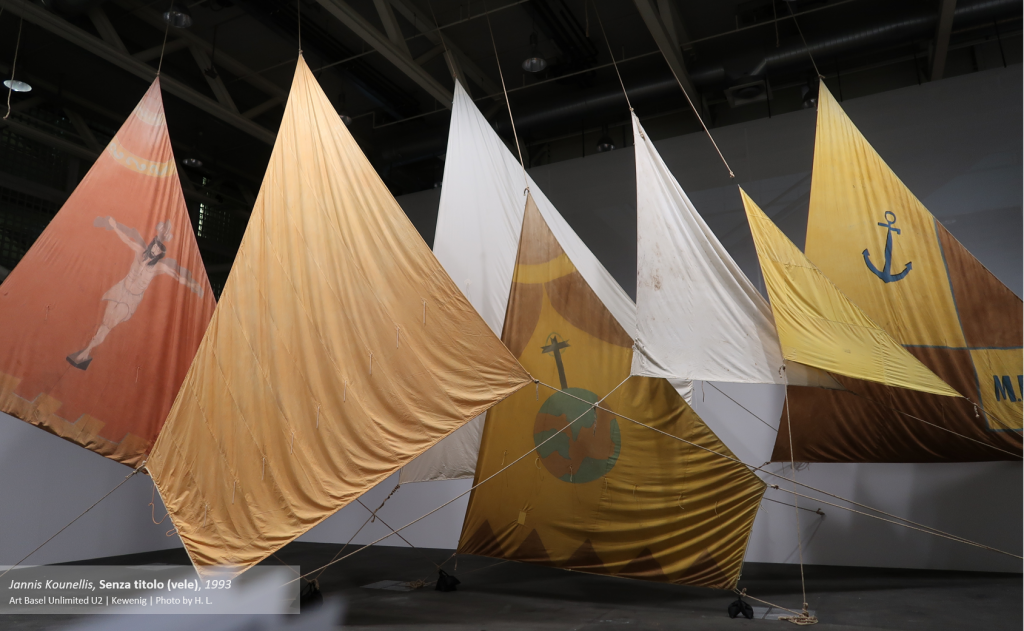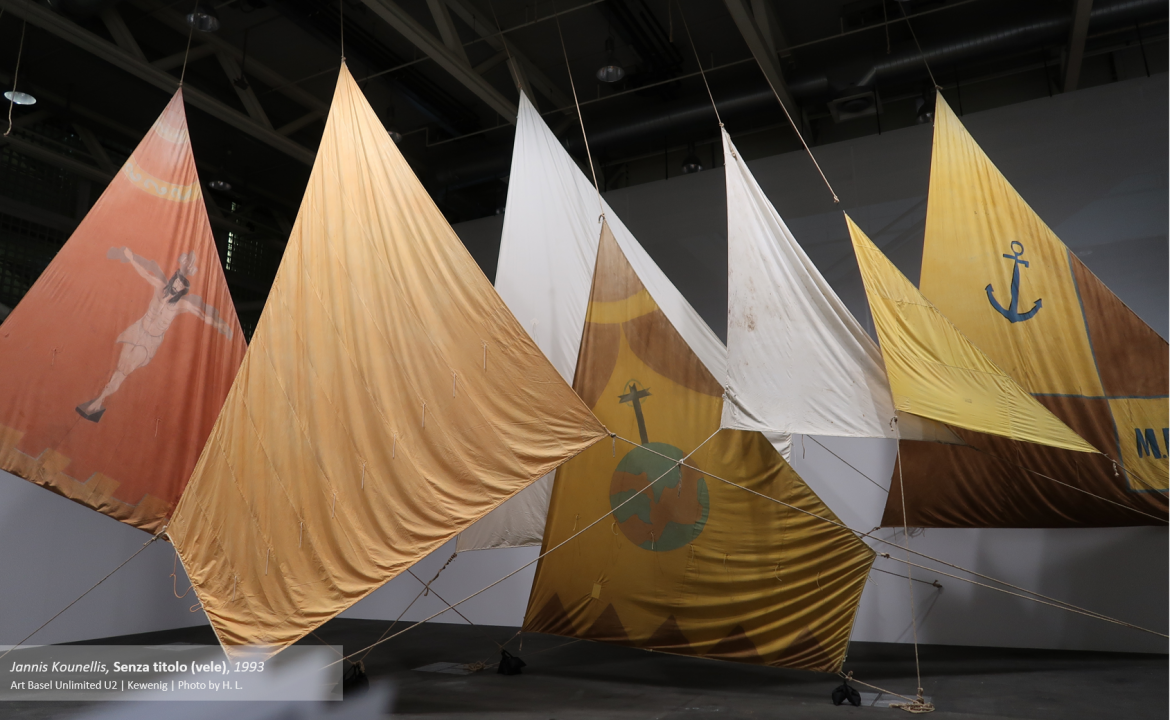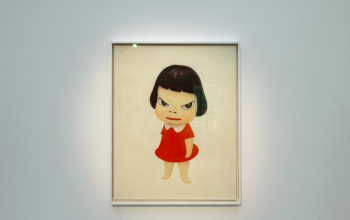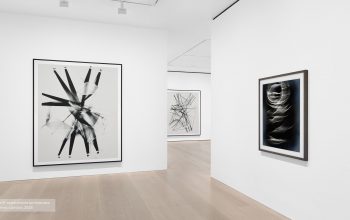Iron, Wind, and Memory

In the practice of Jannis Kounellis, materials are never just matter. They are signifiers of labor, history, exile, and silence. Presented by Kewenig Galerie at Art Basel 2024, the pairing of two major works—Senza titolo (vele) (1993) and Albatros (2001)—unfolded as a poetic dialectic on displacement, fragmentation, and the metaphysical memory of ships.
These are not works about boats. They are works in which the idea of the boat is dismantled, exposed, and turned inside out, becoming a medium through which loss and persistence are negotiated in spatial terms.
The Sail as Floating Signifier
In Senza titolo (vele), nine Venetian sails—some from the 17th century—are suspended in space like a procession of ghosts. Each piece of cloth, weathered and symbolically painted, resists interpretation as a unified image. The sails are not illustrative; they do not depict sailing. Rather, they retain the aura of former functionality, hanging like tattered witnesses to histories of navigation, migration, and imperial expansion. Their vertical orientation recalls both religious banners and tombstones.
What’s most striking is their emptiness. There is no mast, no hull. These sails are disembodied skins, responding only to light and air. Kounellis creates an almost liturgical space, where the absence of wind becomes the wind, and the void beneath the sails becomes a kind of sacred architecture of longing.
Critically, this installation defies the white cube. It builds a corridor of breath—a material choreography of what once moved, but now hovers between symbolic elevation and historical fatigue.
Fragments and Iron: The Broken Logic of Albatros
If vele is about weightlessness, Albatros is its counterweight. Here, the artist returns to the boat not as image, but as relic. The segments of the vessel—originally shown whole in 1991—are now ruptured, mounted on walls like anatomical specimens. Each piece, weather-beaten and salt-stained, is clamped to industrial steel panels that tilt awkwardly, suggesting instability or collapse.
Unlike the ethereal composition of the sails, Albatros is brutally physical. The works lean, groan, and sag. Rust, grain, and fracture are not details but protagonists. Kounellis’ refusal to “restore” the vessel is central to the work’s power: what we witness is not the ruin of a ship, but the ship as ruin.
In its name, Albatros carries the burden of Baudelaire’s great metaphor—the poetic figure who, once aloft and majestic, is now grounded and mocked. In Kounellis’ interpretation, the ship becomes the albatross: once a symbol of direction and commerce, now a decomposing symbol of forgotten labor and arrested movement.
A Sculptural Language of Loss
These works do not ask to be read in narrative terms, yet they are profoundly historical. The poetics of decay are inscribed into each surface: the cracked wood, the unpatched holes, the iron oxidized to the color of dried blood. Time here is not metaphorical; it is literal and violent.
In both installations, Kounellis abandons conventional sculpture. He does not shape mass, but assembles remnants. His language is not formal, but forensic. He offers no monument, but rather a field of semiotic residue—each element speaking of displacement, exhaustion, and suspension.
Importantly, Kounellis eschews nostalgia. The past is not revered, but interrogated. The sail is not hoisted; it is displayed. The boat is not mended; it is dismembered. This is sculpture as archaeology.
Material, Gravity, and Metaphysical Space
What ties these installations together is a metaphysical sense of gravity. One work floats. One sinks. Both evoke the invisible architecture of memory—not what is remembered, but how things are held, suspended, and finally let go.
Kounellis’ genius lies in his material dramaturgy: how sailcloth becomes elegy, how rust becomes testimony, how void becomes form. In this way, he moves beyond Arte Povera into a sculptural mysticism that remains utterly grounded—one that understands that a piece of wood may hold more truth than any symbol.
To Drift and To Break
There is no romanticism in Kounellis’ vision of the vessel. The sea is never seen, but its erosion is everywhere. The ship never moves, but its displacement defines the work. These are not maritime works—they are existential architectures, vessels of grief and resilience.
At Art Basel 2024, the artist’s voice, long silent since his death, continued to sound—not with volume, but with weight.
“I have always believed in the truth of materials,”
Kounellis once said.
These works whisper that truth, in salt, in iron, and in windless sail.



